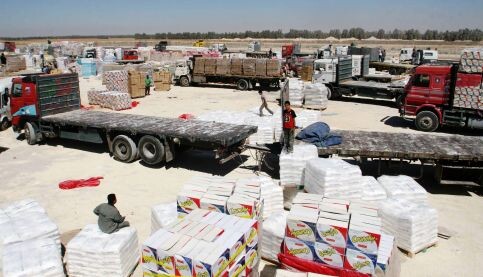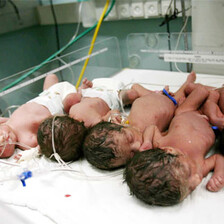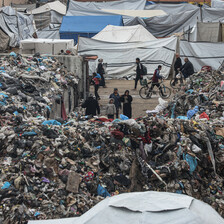The Electronic Intifada 13 October 2010

Goods accumulate at the Israeli-controlled border crossing with Gaza. (Mohammed Omer/IPS)
GAZA CITY, occupied Gaza Strip (IPS) - Samir Tahseen al-Nadeem died after waiting 35 days for an exit permit for treatment for his heart condition. He was 26. The medicines he needed could not get in. But the coffins do.
The health ministry now lists 375 deaths due to shortage of life-saving medicines. The medicines sit just outside the borders of the territory until most pass their expiry dates. But there are no expiry dates on about 10,000 coffins that have been donated for Gaza. The coffins do make it to those who eventually need them.
By the end of last month more than seventy percent of medicines donated for Gaza had been dumped because they were past their expiry date, the health ministry says. They were worth many millions of dollars. And they were worth many lives.
“Much of the donated medicines came from Arab states,” Dr. Mounir al-Boursh, director of the pharmaceutical department at the health ministry, tells IPS. This added up to 10,300 tons of medicines worth 25 million dollars, he said.
Only about thirty percent of this could be used, he said; the rest either expired, or was inaccessible because of restricted distribution by the Israelis, who control what gets into Gaza.
It’s not easy to dump medicines safely, either. Much of unused supply mixes with domestic waste, creating health hazards far from bringing relief. The World Health Organization has had to “raise concern about the unsafe disposal of expired medication and other medical disposable material,” WHO spokesperson told IPS.
But the Gaza ministry has received 10,000 coffins, about 1,000 of them for children, Dr. Boursh said. Such help, he said, “does not meet with the needs of the Gaza Strip.”
What Gaza needs is 110 types of medicines and 123 types of medical equipment that the ministry has listed. Gaza is expected to run out of more medicines over the next few months. The announced ease in the blockade of Gaza has not currently brought more supplies.
The medicines now under threat are for childcare, in the maternity departments, and for conditions such as cancer, epilepsy, hemophilia and thalassemia.
“Death has become routine,” says a young woman from Jabaliya in the north of Gaza Strip as she waits in the corridor at the al-Nasser Children’s Hospital in Gaza City. Next to her, the parents of two-year-old Israa Tabsh are struggling to save the child, born with a heart defect.
“We have been waiting for weeks for permission to leave Gaza for the cardiac surgery she needs,” says the child’s father, Fayez al-Tabsh. The treatment is available at the al-Maqased hospital in East Jerusalem, but Tabsh can’t get there.
The family, like others, first needs an exit permit, and then a financial guarantees statement that all expenses would be met by the health ministry in the occupied West Bank, which is under the control of the Fatah-led administration, unlike the Hamas government in Gaza.
That guarantee is near impossible for most patients. “You need connections,” says a 53-year-old mother waiting for a guarantee for her son. “We are caught between corrupt officials and death.”
Patients in Gaza depend on the West Bank government both for permits and for many needed medicines. In 2010 Gaza received only 22 percent of the medicines it needed from the Palestinian Authority based in Ramallah in the West Bank, Boursh said. Supplies are declining. “In 2008 we had received fifty percent, and in 2009, 49 percent.”
The medicines that come in, and in time, are not easy to preserve. At the old al-Ghifari medical storage in Gaza City, the facility leaks fluids. “It’s the rats,” says a caretaker. “They get to the fluid bags, causing the leakages. The rats get the medicines, the patients the coffins.”
All rights reserved, IPS - Inter Press Service (2010). Total or partial publication, retransmission or sale forbidden.





